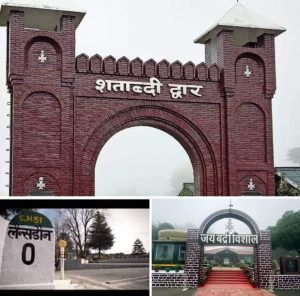Salute to Lat Subedar on the foundation day of Garhwal Rifle-
The early superhero of the military tradition of Garhwal-
Lat Subedar Balbhadra Singh Negi (1829 – 1896)
‘The zone in which heroes like Balbhadra Singh are born must have a separate regiment of its own.’ I wrote this important fact.
On May 5, 1887, the then British government formed the ‘Garhwal Rifle’ by joining the Garhwali and other soldiers recruited in the Gorkha Rifle stationed in Almora and established its headquarters at ‘Karon Ka Danda’ (Lansdowne). Earlier, the youth of Garhwal could be recruited in Gorkha rifle only.
The main architect of the formation of ‘Garhwal Rifle’ is considered to be Lat Subedar and Honorary Captain Balbhadra Singh Negi. His illustrious military journey from an ordinary soldier in the fifth Gurkha rifle to becoming a Lat Subedar (the highest rank of Indian soldiers at that time) was one of outstanding courage, foresight and devotion to duty. The mention of his indomitable courageous military services is recorded in the London Gazetteer. He was awarded the ‘Order of Merit’ twice during his military services. After retiring from the army in 1887, the British government, honoring his meritorious military services, provided 302 acres of land at Ghosikhata (Kotdwar) free of cost and named this place as Balabhadrapur.
Lat Subedar Balbhadra Singh Negi was born in 1829 in Galkot, Aswalsun (Pauri Garhwal). His father Dhan Singh Negi was the lifelong Patwari of Aswalsun Patti. (Balbhadra Singh’s grandfather Chandra Singh Negi had come to Mehad (Mwar) from Siraun village of Aswalasun Patti. His father Dhan Singh Negi moved from Mwar to Galkot. Following the same tradition, Balbhadra Singh after retiring from the army had settled in Galkot. He settled in the nearby village of Haidakholi. He bought the land and property of Haidakholi from an Aswal Thakur of Nagar village by filling ‘Ek Patha Do Mana’ (Grain Measuring Utensil) with Kaldar coins.)
With the beginning of the British rule in Garhwal (1815-16), the process of joining the army had also started. In 1816, the British formed the ‘Nasiri Sirmor Kumaon Battalion’ of Gurkha, Garhwali and Kumaoni youth. In common parlance it was called ‘Khichdi Paltan’. Later it was named ‘Gorkha Rifle’.
The British were originally residents of the hilly areas. For this reason, it was natural for him to have an intimate attachment to the mountains of Garhwal-Kumaun. He wanted to take advantage of the struggling life, good health and honesty of the hills by recruiting them into the army. In the fourth decade of the nineteenth century, it became common for the youth of Garhwal to join the army.
Young Balabhadra also one day quietly set out on unknown paths of life to join the army from his village Galkot. After many days, he reached Kotdwar and from there to Roorkee, along with unknown people he met while walking in the forgotten paths. After facing many troubles on foot along with Gurkha youth from Roorkee, he reached Abbottabad in the North-West Frontier Province and with them stood in the line of recruitment in the Gorkha Battalion. On the strength of healthy stature, his dream of becoming a soldier was fulfilled. Now he became a soldier of 2/5 Gorkha Battalion and started taking military training at Abbottabad with Gurkha recruits. This was in the year 1847.
Showing the qualities of a brave soldier, Balbhadra Singh had become a Subedar in a very short time as compared to his other companions. In the Kandahar War of 1879, Balbhadra Singh had shown amazing valor and understanding. According to the plan of General P. Roberts, he kept spying in the enemy territory for seven days in Pathan disguise. There he took all the secrets of the Afghan army as a dead man among the dead soldiers of his battalion and cleverly returned to his battalion after seven days. On the basis of strong intelligence of Balbhadra Singh, the Indian Army was able to emerge victorious in this war. Due to his courageous campaign, the death rites of many missing soldiers of the Indian Army were possible. Balbhadra Singh was given the ‘Order of Merit’ honor for his important contribution in getting victory in Kandahar war. He was also promoted to the post of Subedar.
He also displayed his bravery in the Kabul War in 1880, immediately after the Kandahar War. Even after being shot in the forehead, he stood on the front of the war for several days. In recognition of his extraordinary courage in the Kabul war, Subedar Balbhadra Singh was again awarded the ‘Order of Merit’. This process of honor did not stop and he was also awarded the Commander-in-Chief’s ‘Sartest Sainik Medal’ and the ‘Order of British India’. Along with this, he was promoted to the post of Subedar-Major.
(The first credit for becoming a Subedar Major among the Garhwalis goes to Balbhadra Singh Negi (Aswalseun) and Moti Singh Negi (Bachanasyun).)
The then Commander-in-Chief Lord Roberts was so impressed with Subedar-Major Balbhadra Singh that he created a new post for him and appointed Governor General Lord Dufferin’s bodyguard (ADC). Now Balbhadra Singh became popular among the general public by the names ‘Sardar Bahadur’ and ‘Lat Subedar’. After being the bodyguard (ADC) of Governor General Lord Dufferin for four years, in 1885, after retiring from the army, Balbhadra Singh came back to his village ‘Galkot’ and started living a normal life. After some time, buying land and property in Haidakholi village started doing farming and staying there.
Balbhadra Singh ji continued the efforts to establish ‘Garhwal Regiment’ after the pension came. Its result was that in 1887 the ‘Garhwal Regiment’ came into existence. Now he got involved in the campaign to motivate the youth of Garhwal to join the army. Honoring Balbhadra Singh ji’s fame and experiences, he was made a nominated member of ‘Garhwal District Board’ for life.
While performing Sandhya Vandana in a wide stone near ‘Baddu ka Pani’ of Gumkhal-Raitpur village during a journey in March, 1896, he was badly injured by a stone falling from a hill above. He was admitted to Sainik Hospital Lansdowne but Balbhadra Singh ji died during treatment.
The effect of Balbhadra Singh’s valor was that his eldest son Amar Singh Negi got the Viceroy’s commission directly. It is said that when Balbhadra Singh received the information of Subedar-Major Amar Singh being seriously injured during the Varma war, he wrote his inspiring message in the reply telegram that ‘Son, don’t panic, if you survive then name And even if you become martyr, your name will be there.’ This is an incomparable example of military dedication. In 2003, the Garhwal Rifle Regimental Centre, Lansdowne organized a grand event to honor the gallant services of Honorary Captain Balbhadra Singh Negi.
It is also important that the four sons of Lat Subedar Balbhadra Singh ji rendered excellent service in the army (A.Captain) and this illustrious family military tradition continues even today in the succeeding generations. Amar Singh’s son Anand Singh Negi wrote self-memoirs focused on his grandfather Balbhadra Singh’s indomitable force-wisdom deeds, the establishment of the Garhwal Rifle and his family military contributions. He completed this autobiography by writing in a note book on September 20, 1960, while serving in Moradabad and Gonda as the secretary of the Zilla Sainik Board. This manuscript is presently preserved in the museum of Garhwal Rifle Regimental Center Lansdowne. Take these self-reminiscences of Amar Singh Negi ji to his son. Col. Mahendra Singh Negi (Sr.) has refined and published as a book ‘History of a Sainik Family’ on March, 2018.
This heroic saga of our pride Balbhadra Singh Negi is a glorious legacy of the military tradition of the mountain. Which should be passed on to the young generation of today. Balbhadra Singh ji was rich in the popular image of a commander with indomitable force and acumen. But apart from this, this quality of his also impressed me a lot that after earning fame and wealth in the country and the world, he came to his village Galkot and then Haidakholi and started living a decent life of common farming. He had given farewell to the status of Lat Subedari as soon as he left the army.
Balabhadra was a symbol of unparalleled respect for the indomitable, powerful and very humble gentleman. In fact, he was an early hero of the glorious military tradition of Garhwal.
Reference literature-
‘History of a Sainik Family’ Anand Singh Negi Balbhadrapur, Kotdwar, March, 2018.
‘Where did those people go’ Dr. Ranveer Singh Chauhan, Radhika Publications, Kotdwar, May 2001.
‘Dead glories of Garhwal’, Dr. Bhakta Darshan, Amar Bharat Press, Delhi, 1952
Dr. Arun Kuksal
book thanks-
Friend Anil Swami ji and Shri Hira Lal Jain ji.
